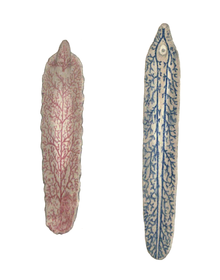Fasciola gigantica
| Fasciola gigantica | |
|---|---|
 |
|
| Cobbold's drawing of Fasciola gigantica | |
| Scientific classification | |
| Kingdom: | Animalia |
| Phylum: | Platyhelminthes |
| Class: | Trematoda |
| Subclass: | Digenea |
| Order: | Echinostomida |
| Suborder: | Echinostomata |
| Family: | Fasciolidae |
| Genus: | Fasciola |
| Species: | F. gigantica |
| Binomial name | |
|
Fasciola gigantica Cobbold, 1855 |
|
Fasciola gigantica is a parasitic flatworm of the class Trematoda, which causes tropical fascioliasis. It is regarded as one of the most important single platyhelminth infections of ruminants in Asia and Africa. Estimates of infection rates are as high as 80-100% in some countries. The infection is commonly called fasciolosis.
The prevalence of F. gigantica often overlaps with that of Fasciola hepatica, and the two species are so closely related in terms of genetics, behaviour, and morphological and anatomical structures that it is notoriously difficult to distinguish them. Therefore, sophisticated molecular techniques are required to correctly identify and diagnose the infection.
Fasciola gigantica causes outbreaks in tropical areas of southern Asia, Southeast Asia, and Africa. The geographical distribution of F. gigantica overlaps with Fasciola hepatica in many African and Asian countries and sometimes in the same country, although in such cases the ecological requirement of the flukes and their snail host are distinct. Infection is most prevalent in regions with intensive sheep and cattle production. In Egypt F. gigantica has existed in domestic animals since the times of the pharaohs.
The life cycle of Fasciola gigantica is as follows: eggs (transported with feces) → eggs hatch → miracidium → miracidium infect snail intermediate host → (parthenogenesis in 24 hours) sporocyst → redia → daughter redia → cercaria → (gets outside the snail) → metacercaria → infection of the host → adult stage produces eggs.
...
Wikipedia
